
© Railway Wonders of the World 2012-

| Advertisements |
| Articles by Cecil J Allen |
| Binding |
| Cookie Policy |
| Covers |
| Donate |
| FAQs |
| Illustrations |
| More on Railway Wonders |
| Other Series |
| Privacy & Terms of Use |
| List of Illustrations |
| Locomotive Illustrations |
| Carriage Illustrations |
| Wagon Illustrations |
| Part 1 |
| Part 2 |
| Part 3 |
| Part 4 |
| Part 5 |
| Part 6 |
| Part 7 |
| Part 8 |
| Part 9 |
| Part 10 |
| Part 11 |
| Part 12 |
| Part 13 |
| Part 14 |
| Part 15 |
| Part 16 |
| Part 17 |
| Part 18 |
| Part 19 |
| Part 20 |
| Part 21 |
| Part 22 |
| Part 23 |
| Part 24 |
| Editorial - Part 1 |
| Editorial - Part 2 |
| Editorial - Part 3 |
| Editorial - Part 4 |
| Editorial - Part 5 |
| Editorial - Part 6 |
| Editorial - Part 7 |
| Editorial - Part 8 |
| Editorial - Part 9 |
| Editorial - Part 10 |
| Editorial - Part 11 |
| Editorial - Part 12 |
| Editorial - Part 13 |
| Editorial - Part 14 |
| Editorial - Part 15 |
| Editorial - Part 16 |
| Editorial - Part 17 |
| Editorial - Part 18 |
| Editorial - Part 19 |
| Editorial - Part 20 |
| Editorial - Part 21 |
| Editorial - Part 22 |
| Editorial - Part 23 |
| Editorial - Part 24 |
| Part 25 |
| Part 26 |
| Part 27 |
| Part 28 |
| Part 29 |
| Part 30 |
| Part 31 |
| Part 32 |
| Part 33 |
| Part 34 |
| Part 35 |
| Part 36 |
| Part 37 |
| Part 38 |
| Part 39 |
| Part 40 |
| Part 41 |
| Part 42 |
| Part 43 |
| Part 44 |
| Part 45 |
| Part 46 |
| Part 47 |
| Part 48 |
| Part 49 |
| Part 50 |

British Enterprise in South America
The Activities of Two Important Systems
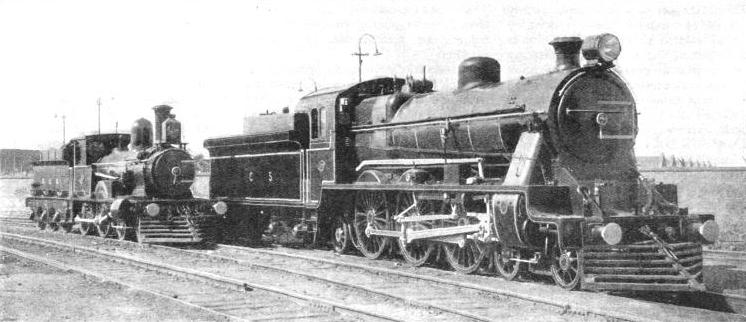
THE OLD AND THE NEW. An interesting comparison between two types of locomotive on the Buenos Ayres Great Southern Railway. On the left is an old passenger engine built in 1902, while on the right is a modern express “Pacific”. The earliest section of the railway system, now operating over 5,000 miles, was opened in 1865 between Buenos Aires and Chascomus, a distance of 71 miles.
THE opening up of South America by railway is one of the great achievements of modern times. In Argentina the develop-
Some of the important Argentine railways are described in the chapter “By Rail in the Argentine”. Particulars of the largest British-
The privately owned railway with the most extensive mileage in Argentina is the Buenos Ayres Great Southern Railway, which is a British concern. It is closely associated with another British-
The total mileage of the Buenos Ayres Great Southern is 5,085 (including allied Companies), and it serves the southern part of the province of Buenos Aires, with one line extending across country to the National Territory of Neuquen, near the Andes. It links the most important ports of the country, including Buenos Aires, the capital, Bahia Blanca, and Carmen de Patagones. The Buenos Ayres Western Railway has a total mileage of 1,930, and serves the western part of the province of Buenos Aires and part of the Pampa Territory. Both railways have highly important suburban sections in Buenos Aires.
Rolling stock of the Great Southern comprises 850 locomotives, over 1,400 coaches, and about 17,000 other vehicles. The locomotives include twenty-
The Western Railway has 290 locomotives, 540 coaches, and about 7,500 other vehicles. The locomotives on this line include six up-
An intensive suburban service is maintained between the Buenos Aires terminus of the Great Southern, Plaza Constitución, and the suburbs of Temperley, Quilmes, and other stations farther out. There are four tracks between Buenos Aires and Temperley.
The terminus of Plaza Constitución deals with over 400 trains daily. Although the local service is mainly steam-
On the main lines of the Great Southern the principal towns are served by day and night trains provided with restaurant and sleeping cars. In the summer months the main line to the seaside resort of Mar del Plata is much used. Although it is only a single line from a point fifty-
On the opposite side of Argentina is the lovely Lake Nahuel Huapi, which lies 2,500 ft above sea-
A 1,700 horse-
The principal goods station of the Great Southern is Sola, in the southern part of Buenos Aires city, and from it train-
Telephone Train Control
Other important traffics are livestock, stone from the Tandil and Olavarria districts, potatoes from the Balcarce and Mar del Plata zones, and petroleum and its by-
Both railways are equipped practically in their entirety with telephone train control, with divisional control offices in Plaza Constitución and Once (Buenos Aires) and Bahia Blanca. The Great Southern has eight locomotive operating districts, and the Western has four; the largest is at Remedios de Escalada, seven miles from Buenos Aires, where over 200 engines are stationed.
Bahia Blanca, the “White Bay”, is about 397 miles from the capital, and has a population of over 100,000. It is some twenty miles from the Atlantic on an inlet resembling an estuary. It has two ports, Puerto Ingeniero White, built by the Great Southern Railway, and Puerto Gal van, constructed as an outlet for the Bahia Blanca North Western Railway, which is under the management of the Great Southern.
Both ports are operated as one, serving the whole of the southern part of the large and fertile province of Buenos Aires, and the rapidly developing territories of the Pampa and Rio Negro. The bulk of the export traffic consists of grain, principally wheat, of which up to two million tons have been shipped in a year. In addition to this, up to half a million tons of other classes of grain, chiefly barley, oats, rye, and linseed, have been exported through Bahia Blanca.
To cope with the increasing grain traffic, in 1908 the Great Southern built two elevators at the port of Ingeniero White, with a jetty providing berthing accommodation for four steamships. Each elevator has a storage capacity of 13,216 tons. As time went on and grain production increased it became necessary to add to these facilities, and in 1932 a modern central elevator of 80,000 tons capacity was built. It has up-

EIGHT-
The figure of 80,000 tons is the storage capacity, the handling rate on the incoming side being 1,200 tons an hour, while on the outgoing side six steamships can be loaded simultaneously at the rate of 1,000 tons an hour each ship. This elevator is claimed to be the largest in South America. The equipment includes 120 conveyers, and there are over twelve miles of conveyer and elevator belting. The 80,000 tons of wheat are equivalent to about 3,000,000 bushels.
Grain wagons are unloaded in a shed 602 ft long and 134 ft wide; it is open at either end, and has six railway tracks of 5 ft 6-
The present extensive system of the Great Southern Railway has grown from the original concession to build a railway about seventy-
Ambitious Reconstruction
Irrigation works constructed by the railway for the Government in the territories of Rio Negro and Neuquen, in conjunction with the building of the lines in these regions, have transformed a large stretch of wild country into a fertile area producing crops and fruit. Thus, at one end the railway operates in one of the great cities of the world, transporting the business man from his office to his home in a suburb, while at the other it is taming the wilderness and making it fit for settlers. The railway has also made ports to enable the settler to ship his crops to Europe.
The Great Southern has undertaken such diverse tasks as making a canal seventy-
Repair shops of the Great Southern at Remedies de Escalada, seven miles from the terminus, are the largest in South America, and employ nearly 3,000 men. Although primarily for repair work, the shops are equipped to make every part of a locomotive or a railway carriage. The railway controls and works the South Dock, Buenos Aires, at the mouth of the Riachuelo River.
Another terminal port is at Rio Santiago, about five miles from La Plata, the capital of the province of Buenos Aires, thirty-
Miramar, Necochea, and Quequen are seaside resorts served by the Great Southern, Quequen being about two miles from Necochea across the Quequen Grande River, and 307 miles from the capital. Quequen is also being developed as a port for cattle and grain.
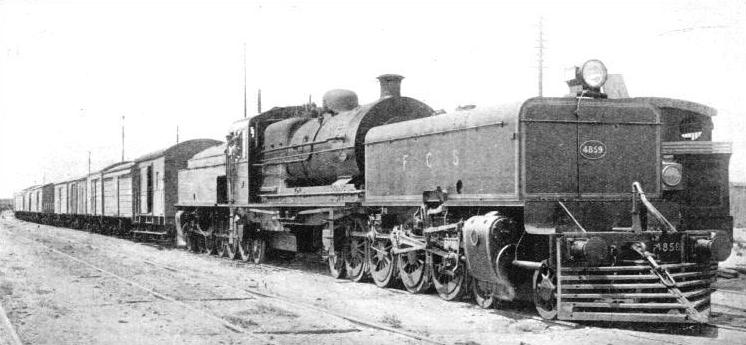
HEAVY GOODS ENGINE of the “Beyer-
The issued capital of the Southern is more than £72,000,000, and it is one of the most notable examples of British railway enterprise in South America.
The Buenos Ayres Western Railway operates west of the capital between the zones of the Great Southern and of the Buenos Ayres and Pacific Railway. The system extends in the direction of the Andes across an agricultural and cattle country to the vine and fruit region of the province of Mendoza. It has the distinction of being the oldest railway in Argentina, as it includes the first line, opened in 1857, between Buenos Aires and Flores, a distance of six miles. In those days Flores was a separate town, but it is now in the centre of the municipal area of Buenos Aires.
This line decided, in a curious way, the gauge question. The equipment was made for use in India for the broad gauge there, but when the Crimean War broke out in 1853, the lines and rolling-
The first locomotive was a veteran of the siege of Sebastopol, and was named “La Porteña”, when it arrived. The original rolling-
Between Two Rivers
Another British line is the Entre Rios Railway, which operates in the province of that name, which means “Between Rivers”, and is bounded by the rivers Parana and Uruguay. The mileage is 810, and the gauge 4 ft 8½-
8½-
The original concession granted in 1864 for a line, now forming part of the system, was for the broad gauge, but the railway company persuaded the Government to alter the gauge to standard, as the lines in the neighbouring countries of Uruguay and Brazil were of standard gauge. The system is part of the through route from Buenos Aires to Ascunción, the capital of Paraguay. It goes north from Concepción del Uruguay and Concordia to Monte Caseros and on to Posadas, on the Paraná River opposite the town of Villa Encarnación, in Paraguay. From this point trains go to Asunción.
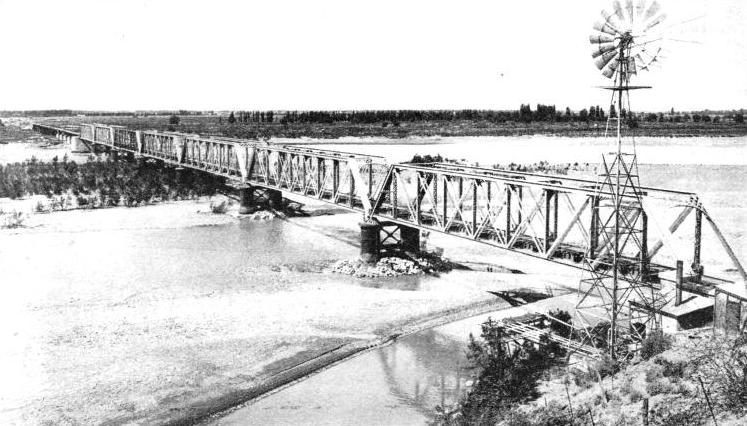
NEUQUEN BRIDGE, on the Buenos Ayres Great Southern Railway, is typical of the many fine engineering works to be found on this system. In the Neuquen territory irrigation works have been constructed for the Government by the railway in conjunction with the laying of lines in this district, and the region has been converted into a productive agricultural area.
Another line of the system goes from Monte Caseros to Corrientes, capital of the province of that name near the confluence of the Rivers Paraguay and Paraná, and 750 miles from Buenos Aires.
French enterprise also has contributed to the railway development of the country, the principal French company being the Province of Santa Fé Railways, which owns over 1,250 miles of metre-
The Argentine State Railways control 5,764 miles of lines varying from the broad gauge to 2 ft 6-
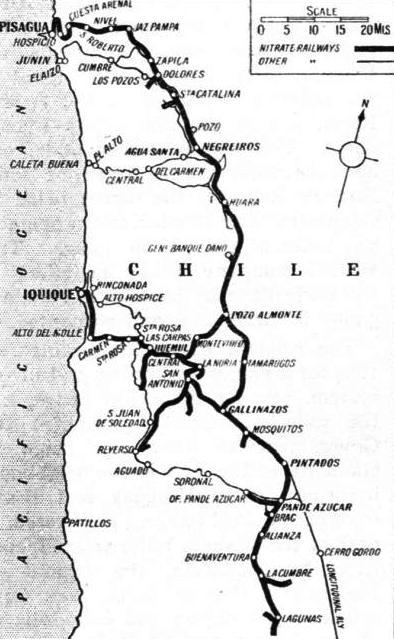 Chile is an extraordinary country geographically, as it consists of a ribbon of land from between sixty and 180 miles wide running down the Pacific Coast of South America for about 2,800 miles, from the tropics to stormy Cape Horn, and affording a striking variety of altitudes and temperatures. For a great part of its length it is hemmed in on the east by the mighty Andes. It is bounded on the north by Peru and on the east by Bolivia and Argentina, the Pacific Ocean forming the western boundary. The area is about 289,810 square miles, and the population at the 1930 census was about 4,287,000. The language of the country is Spanish.
Chile is an extraordinary country geographically, as it consists of a ribbon of land from between sixty and 180 miles wide running down the Pacific Coast of South America for about 2,800 miles, from the tropics to stormy Cape Horn, and affording a striking variety of altitudes and temperatures. For a great part of its length it is hemmed in on the east by the mighty Andes. It is bounded on the north by Peru and on the east by Bolivia and Argentina, the Pacific Ocean forming the western boundary. The area is about 289,810 square miles, and the population at the 1930 census was about 4,287,000. The language of the country is Spanish.
OVER 400 MILES of standard gauge track in Chile are operated by the Nitrate Railways Company. The construction of the railway was begun about 1865 and taken over by the present owners in 1882. The system, linking the nitrate ports of Pisagua and Iquique, constitutes one of the chief arteries of transport in the nitrate area of Northern Chile.
British railway enterprise has played an important part in the development of the country, and particulars of the largest British line, the Antofagasta Railway, are given in the chapter “The Magic of the Andes”, as stated earlier in this chapter.
The oldest nitrate-
When the railway system in the province of Tarapacá was begun about the year 1865 the territory was Peruvian, but, after the war between Chile and Peru and Bolivia in 1883, the provinces of Tarapacá and Antofagasta were ceded to Chile. The deposits of sodium nitrate are found only in north Chile, and the primary purpose of the railways was to bring the nitrate expeditiously to the coast, since the progressive increase in the exportation of nitrate and soda had made it apparent that the transport of the commodity by mule carts, a method which had existed since about the year 1830, was no longer adequate for the needs of this industry.
At one time these nitrate deposits made Chile one of the most important countries in the world, as nitrates are essential for the production, among other things, of high explosive and fertilizers; but since the war of 1914-
As Tarapacá, with its still valuable deposits of nitrate, is a rainless desert, the railway pioneers had always to contend with the problem of water, in addition to that of gradient, because of the hilly nature of this part of the country. The cost of water is considerably in excess of that incurred by most railways, although, on the other hand, the company is not harassed by the wash-
The original concessionaires transferred the lines in 1873 to a company known as the National Nitrate Railways of Peru, which was later, in 1882, reconstituted as the Nitrate Railways Co, Ltd. The system is worked under four separate concessions, the principal terminus being at Iquique, one of the chief ports of Northern Chile, with a population of over 37,000. It hardly ever rains in Iquique, and water has to be brought sixty miles from the oasis of Pica. The railway company has a condensing plant at Iquique capable of supplying distilled water from sea water at a rate of 200 tons in twenty-
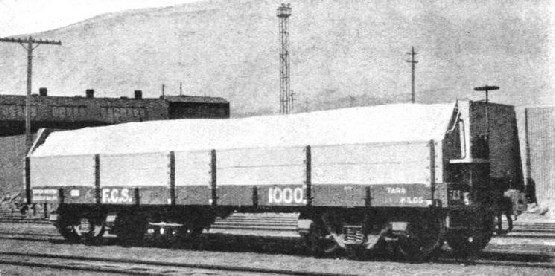
STANDARD FLAT WAGON used in Chile for carrying nitrate. Fitted with wooden sides, this wagon is capable of holding 28 tons of nitrate in bulk. Nitrate was formerly conveyed in sacks, but this method has been largely discontinued in favour of bulk transport.
About half the total mileage of 400 is main line, single track, the other half consisting of branch lines to the nitrate-
The carriage and wagon shop accommodates about 180 wagons, and the locomotive running shed has a capacity sufficient for fifteen locomotives. The yard at Iquique has four weigh-
The mole at Iquique is equipped with two electric travelling cranes of two and five tons capacity respectively. A forty-
Pisagua, the northern terminus of the railways, was at one time as important for shipping nitrate as Iquique, but all exportation from Tarapacá to-
A Reversing Station
The first section of the system involved some problems, as the line has to climb directly it leaves the terminus at Iquique. About four miles from Iquique there is a reversing station, and the track climbs up to Molle, ten miles south of Iquique and 1,611 ft above sea-
The line as far as Las Carpas forms the Iquique Bank Section, some of the gradients being more than 1 in 25, with sharp curves uncompensated. After Las Carpas the line is much easier, as it passes through Huemul (twenty-
Central, which lies at an altitude of 3,220 ft, is the junction of the La Noria and Lagunas line with the Pozo Almonte and Pisagua line. It is also the station for trains going from Iquique to these two divisions, and for trains meeting on their way from different branches to Iquique. There are an engine shed and a workshop for minor repairs, and engines are stationed there for work on the nitrate pampa. Beyond the station the line divides, one track going north and the other south.
On the line going south the first station is La Noria (thirty-
San Antonio is one of the principal railway junctions of the system, and main-
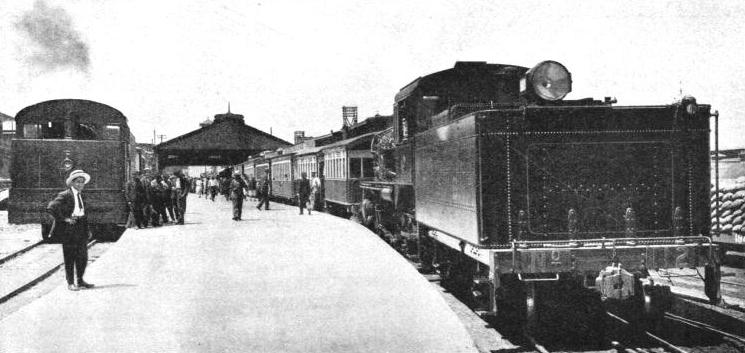
AT THE PORT OF IQUIQUE, on the lines of the Nitrate Railways Co, Ltd. Although the railway was primarily constructed for the conveyance of nitrate, a large number of passengers travel on the system, which possesses twenty-
From Gallinazos to Buenaventura, a distance of thirty miles, the line is almost level. After passing Mosquitos Station, from which three short lines serve three nitrate plants, Pintados (sixty miles) is reached. This station is the junction for the Longitudinal Railway which goes to the south of the Republic of Chile.
The Nitrate line turns south to the terminus at Lagunas, eighty-
The line going north from Central Station climbs to Montevideo, thirty-
The northern line gradually rises to Huara, sixty-
Waterless Territory
Zapiga (ninety-
The rails vary from 85 lb to 62 lb, the service sidings to the nitrate plants being laid with the 62 lb rails. Train movements on all sections of the system are controlled by telephone from the Central Movement Office in Iquique. The Nitrate Railways have played a vital part in the development of this remarkable region, which is one of the strangest in the world. In addition to the handicap of perpetual drought, all food and fuel have to be imported, so that the railway has to bring supplies to the oficinas, or nitrate works. There are vast stretches of country where there is no vegetation. Under the surface, however, lies the caliche, as the crude nitrate of soda is called. This is extracted and taken to the plant where it is crushed, boiled, filtered, and crystallized. The oficinas are surrounded by the dwellings of the workers, and form villages in the desert.
At one time many thousands of workers and their families lived in this region, but the production of synthetic nitrates altered the economic position, and a large number of works went out of production. Recently, however, there has been a partial revival in the consumption of Chilean nitrate, and railway traffic has improved.
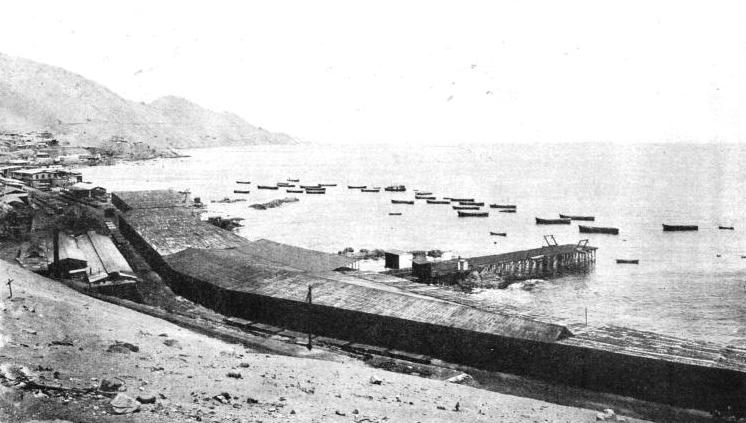
NITRATE WAREHOUSES at Pisagua, showing the rails and some trucks alongside them. The railway has played a vital part in developing a region of perpetual drought, where food and fuel have to be imported and brought to the nitrate workings by rail.
The nitrate plants and the railways locomotives use considerable quantities of fuel. Formerly, imported coal was consumed and then imported petroleum, but recently the coal mines of Chile have been much developed and so Chilean coal is displacing oil. This change has had an important effect on the railway company, as it owns 198 petroleum tanks, for which there is now little use, because the demand for petroleum has fallen off. At the same time numerous locomotives have been converted to coal burning.
Another change was due to the fact that, whereas the nitrate was formerly carried in sacks, this method has been largely discontinued in favour of bulk transport. Since the wagons were designed to carry nitrate in sacks, that is to say, they were flat cars without sides, many of them had to be altered to carry not only this commodity in bulk, but also coal.
There are sixty-
The principal traffic is nitrate, after which come fuel, passengers, perishables, parcels, general merchandise, and live stock. The weight carried in 1934 was some 440,000 tons, and the number of passengers, first and second class, over 120,000. There are twenty-
The Longitudinal Railway
A few years ago the Government extended the Longitudinal Railway, which is of the metre gauge in this part of Chile, from the former terminus at Pintados to Iquique, and thus entered into competition with the Nitrate Railways. This Longitudinal Line is part of the Chilean State Railways, and now traverses Chile from Iquique to Puerto Montt in the south. Some 3,445 of the 5,530 railway mileage of Chile is State-
The State Railways are of metre and 5 ft 6-
Santiago, the capital, is 116 miles from Valparaiso, the principal port of Chile, and the railway is electrified, expresses taking three hours for the journey. The trains climb from Valparaiso to 1,700 ft, at which altitude Santiago is situated. From the city can be seen the snow-
Santiago is the focal point for the State Railways. Projects have been sanctioned to provide additional railway links with Argentina. Chile's rail development is of importance to Bolivia and to western Argentina, as the Chilean ports provide an outlet for trade.
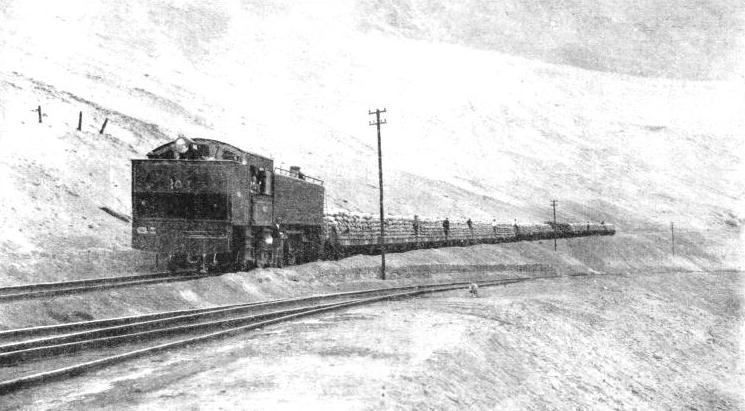
NITRATE TRAIN hauled by a powerful tank locomotive. The Nitrate Railways own some sixty-
You can read more on “By Rail in the Argentine”, “A Gateway to Brazil”, “The Magic of the Andes” and “Main Lines of Brazil” on this website.